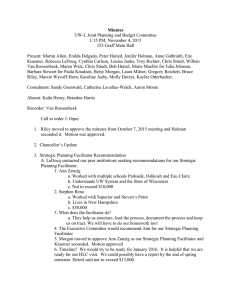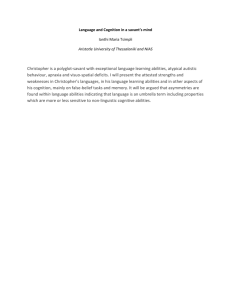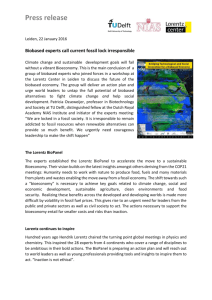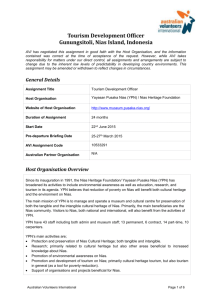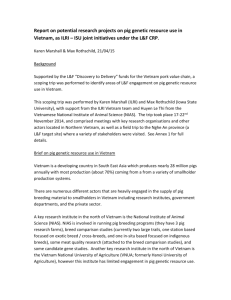tftW %Jij ~ O
advertisement
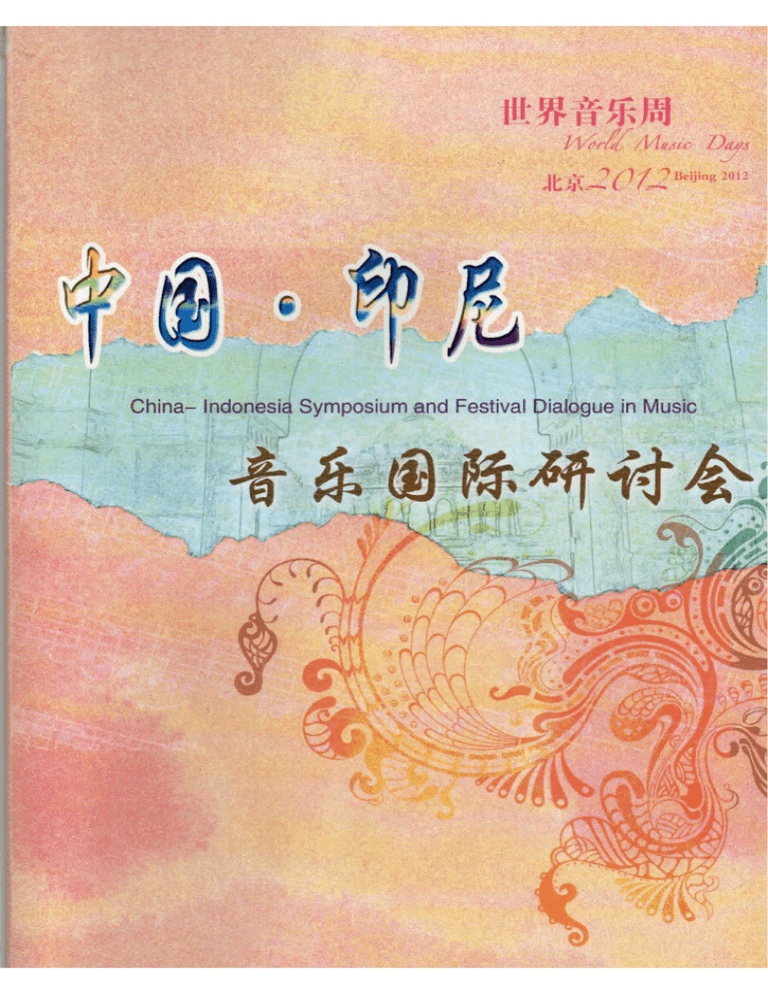
tftW~%Jij
1'111Ht(MQ.5l<=
II; f •1 _...,
..f &.. ., J ., a--,,.;
O l.:-.
./ ~
D11fr
...,,
Beijing 2012
China- Indonesia Symposium and Festival Dialogue in Music
World Music Days, Beijing 2012
China-Indonesia Symposium and Festival Dialogue in Music
Schedule
7th. November 2012, Wednesday
08:30-09:00
Registration
CCOM Friendship Hall
09:00-10:30
World Music Teaching Forum
Chair: An Ping. Wang Zhou
CCOM Recital Hall
I 0:30-12:00
Angklung Performing Practice I
CCOM Recital Hall
12:00-14:00
Banquet
CCOM Canteen
14:00-15:30
Balinese Gamelan Performing Practice I
CCOM Recital Hall
15:30-16:00
Coffee Break
Seventh Floor Lobby, Academic Building
16:00-17:30
Panel Discussion on Diaspora's Music: Dialogue between Nanyin in China and in
Indonesia
Chair: Li Xin
Conference Hall, SeventhFloor. Academic Building
18:00
Cocktail Party by the Indonesian Embassy
CCOM Friendship Hall
19:30
Opening Concert: Indonesian Music Collection and Nanyin
CCOM Recital Hall
8th. November 2012, Thursday
Scholar Session
09:00-09:30
J
Chair: Djohan
s
Suwarta Zebua: Hoho Song in the Present Nias Society
7
Perfomers:
Su Shiyong: Nanyin's inheritor of the National Intangible Cultural Heritage: The master instructor
of School of Music and Dance, Quanzhou Normal university.
Cai Jin niang: Member of Indonesian Oriental Music Foundation.one of the founder members.
Wu Lifcng: Member of Indonesian Oriental Music Foundation.
Chen Zhengmei: Master student of School of Music and Dance, Quanzhou Normal University.
(Major in Nanyin Flute)
Zhuang Zhonghe: Master student of School of Music and Dance, Quanzhou Normal University.
(Major in Nanyin Flute)
Cai Beilei: Undergraduate of School of Music and Dance, Quanzhou Normal University. (Major in
Nanyin)
if
2012
11 J-j 8 13 (£W]Q])
8th. November 2012, Thursday
~*~WScbolar Session
09:00-09:30
.±:!#A: 3f¥
I
Chair: Djohan
"$1Ct!f • Jl';(fn!E:
<JIHfWT~~~±~~ "111111" B!trtt!»
~*~~~-t~~*~1:3"ff
09:00-09:30
Suwarta Zebua: Hobo's Song in the Present Nias Society
Conference Hall, Seventh Floor, Academic Building
·ll i~
'*
~ 4- )!} I r. , [;fl JJl M ~tj \fr. IE IAJ :$'~ 1¥:r ,I;·- J;i fr M. 1Ji: }B iIJiJ~ ~ !it tr~ l¥J 6}f~ , ill -kl] .JA .,Jc ili
JJJlu:tf~Jb W.Wift-t,i:p "ltufJII"
5U(,]Wf~. ~ TJE ifLWrAtt1t!!.fl'J1::ffii:f:i 1¥J~~~1Jfiiim
~m~~~.~~WFR"~·,,·~~~m~.*WF~~hTJAx~WF~l¥J-~-~--·
AA~~~ JE ~f:Wr A l¥J l(JUifr tt.
~7··~~~B.*x~™7~~~~·ffl~WWl¥J•~*WF~R~1¥JJBW~A~W
tl~r
"if~" cfXr!!Jtt a m·~mrtr
1¥1~:x..
x1tft.: JMt-J,l{f{~.&;t;Lj:,o.w., ~ ffi'.f11~ }fd'.:/tRTI x
¥~D7MJE~Wi~~ ....... r!!J*:X.1¥JWM.~~.*WF~-~ftffl~~~-~1J~W
~~~m~1J~.nTm-T•~*.M~~m~1ur~~~*~fi.H~x~*~~£w
JUT~ I: 1: l'i<J JJJH ~ f-1:.
liJf nMJR f.JtJHi!iit: "lllli ~" ~IX illl ::f ffH&>u1'f M flg{;Jt ~ lfirt: JiJT :fl j,f ffi i* 1:riTr~ -# ~~,
'e: ~J.J-ft1m#J11:~.tt!!fv:~f~,J.~. 111~ 12 qv.J~+t ~ mul "1rMnm .. i:fX 1tt1 a:1tl!. ffJ~ri,r-1:mi:r 1¥11117
J IL 't:JJft'tl'fJ J)JflEfJl f.>l +& t!cJ.J -#
s: 1-tJfHI· ;fl1 ITU r',l,.
Studies on Nias traditional music has been done by both Indonesian and foreign scholars.
However, studies on the meaning of Hoho 's song in Nias society have never been conducted. This
matter is considered crucial seeing that the people of Nias have gone through changes on various
aspects of their life. This research aims to revealing the meaning of Hoho 's song for present Nias
people as be seen from the cultural studies perspective.
16
To understand the issue mentioned above. the theory of articulation proposed by Stuart Hall was
applied to study how the people of Nias recently view the meaning of the Hoho 's song in their
everyday life. The concept of production of culture and its relation to representation, identity. and
music aesthetics complemented to the understanding of the meaning of Hoho in the Nias society.
For that purpose, this research applied the qualitative research design with the ethnographic
approached as the primary method. Beside the primary data, the secondary data were used to
completed the text analysis and megalithic cultural context, as well as the modernity in Nias.
The results of these research summarized that the Hoho 's song are no longer believed as a spirit
that influenced the life of its supporting society, the Hoho s song as a sign to forced the social
status, the present Nias society doubts the function of the Hoho s song in their real life and
recently the function of Hoho s song just as the cultural accessories and commodities.
Keywords: Hoho s song, music functions , society changes
B-ffl~k~~~~~*~~-~--~~~.e~~&ffl"~~*~~-*~~~~
~+~~.B•ffl~k~&~~~••~•w~~+~~·•T~fflB~~*m~mm~~
~~~mt. ~A,illm~TB~~m~~~~•*~m~~~~.
Suwarta Zebua
Lecturer in Department of Music Education, Language and Arts Faculty, Yogyakarta State
University.
Doctoral student in Graduate School of Indonesia Institute of the Arts, Yogyakarta (Indonesia). He
completed his BchMus in School Music at the Indonesia Institute of the Arts. He earned his
Master of Education in Technological and Vocational Education, Yogyakarta State University
(Indonesia). Until now he active to studies and develop Nias traditional music in Yogyakarta.
09:30-10:00
~Wr*1J~ •
~*~~~--t;~~**is-ff
•*m:
Olficit{E:f:§$~-&;rti:p:fi1glf!ff*f!tl9~~»
Asri Muchtar: Tire Role of Gandang Toso on Building Spirit in Tabuik Ritual
09:30-10:00
Conference Hall, Seventh Floor, Academic Building
n~
r
*
-0: 1Jtj Ji~
JJ,1 ,9:i (l{J ffi" JJ1 l'iDt 1-t rp • ~ rt~- AA J..1 El iii:~ , M J rf i tk IE fl IJ-1 ~ ~ 15( J'.\ f&
J..1 ~.!A!.. ~ 1'rJt;tn !k: 15(;:t '-1-1, A 11'J 'r1nfHJ..J.J ~ ~- rm:JJO~:M1f15(:rt~!J~mlf.X:.f115t~. mi 1'f.lff
;(fjfl15(~~. ffm~~m~t~~m~.m~ft{>(~M-~~~~~m~.~~Tm~ftM
~*,fll$1'l;(fj rf{,11/i-E.l'.!~11:~WH1l1ffl.!IM V.:A<Jlff;(fj fl1Ji0,1J. ITIJ ~T ~!J!IJJtn;ff-15(.:i:tn<J.UHr. Jt ff ~'I;,
r!i· JJ. lM-Wi .ITH-1' ~11JJ1J TftJ~.f)H1~.
:~(t''.JB·Jf1x'-il>DJ ·f91t6V~A''.l'ti'/it.
ts >J1J M (1:-&.rt,~Jiflxr.:~~M}.
17
r
Wi-t-1JU11H~JA·ht.fmfJ·· rr-.tR r[@
THE HOHO SONG IN THE SOCIETY OF THE PRESENT NIAS ISLAND
Suwarta Zebua
suwarta_z@uny.ac.id
Abstract
Research on the traditional music of Nias Island has long been conducted,
either by Indonesian or foreign researchers. However, research on the meaning of the
Hoho song in the society of the present Nias Island has not been done. The aim of this
study is to uncover the meaning of the Hoho song based on the views of the society of
the present Nias Island seen from the perspectives of cultural studies. For
understanding the topic above, the traditional concepts proposed by Giddens are used
to study how Nias society gives meaning to the Hoho song in their daily life. The
concepts of the production and consumption of arts and their relation to the
representation, identity, and enjoyment of music will complement this understanding.
This study uses the qualitative research design with ethnography as its main method.
In addition to the primary data, secondary data are used to support the understanding
of Nias cultural arts. Research results show that the Hoho song in the traditional Nias
society has undergone shifts in meaning as presently experienced. This is evident from
the fact that the Hoho song is performed for the mere sake of tradition lacking the
values of entertainment or performance. The conduct of Hoho song in traditional
ceremonies is seen as weighting so that it needs adaptation.
Key words: meaning of Hoho, Nias society changes
A. Introduction
The Island of Nias, which lies to the west of Sumatera, is known as one of the
heritages of megalithic cultures in Indonesia which still exists to the present time
(Koestoro & Wiradnyana: 2007). In the villages of Nias, such as Hilisimaetanö and
Bawömataluo in South Nias or Sihare’ö Siwahili in West Gunungsitoli, can still be seen
traditional elevated houses stretching along with yards made of finely arranged stones.
Despite the earthquake in 2004 and Tsunami in 2005, these traditional houses remain
intact up to now. Houses in the northern part of Nias are oval in shape, while those in the
south are rectangular. It is in the yards of these houses that ethnic ceremonies of the Nias
society take place. And it is during these ethnic ceremonies that arts, especially the
traditional Hoho song, are generally performed. These facts have attracted the attention of
the researcher.
Culture and art researchers have been present in Nias Island since the late 19 th and
early 20th centuries, and have been active again in the 1980s. Most of the research results
1
are published in Dutch, German, and English. Publication in Indonesian or in Nias
language is not much. Publication of research results tends to be difficult to find and this
may be one of the reasons for the lack of understanding of Nias cultures. However, the
recent time has seen the efforts to document Nias cultures either by the Government or by
culture researchers, such as done by Nias Heritage Museum in Gunungsitoli.
Early research on Nias arts and cultures has been more ethnographic, especially
on the studies of cultural materials. Modigliani (1890) documented a lot of Nias cultural
aspects. Sundermann (1891) wrote down the Lailo text (one of Nias songs). Fries (1907)
stated that many Nias traditional songs disappeared and replaced with choral songs and
church hymns. The same things were documented by Steinhart (1937) who conducted the
study in Batu Island, South Nias.
Research specific on Nias music has been conducted by the Dutch
ethnomusicologist Jaap Kunst (1937). Prior to this, Schroder in 1917 wrote about Nias
music including its instruments. It is in 1987 that Patton specialized his study on Hoho in
Bawömataluo, South Nias. In his dissertation, Patton tried to compose Hoho genre based
on indigenous criteria. He developed the Hoho classification based on the song shape and
textual material. He transcribed four Hoho pieces and analysed the musical features based
on the form, rhythm, melody, and interval.
Further on, Manhart, in his dissertation, “Song for Lowalangi” (2004), studied the
interculturalization of Nias music by the Catholic Church missions. According to
Manhart, the Catholic Church in Nias had tried to compose service music taking musical
elements of Nias. The Hoho song was also used as a basis for the writing of church songs.
In 2006 Sadieli Telaumbanua studied the Hoho song in his dissertation. The analysis was
more textual of the creation myth regarding the origin of Nias based on the lyrics in the
Hoho song.
Based on these studies, it is apparent that the Hoho song still exists in the midst of
the society and is actively used in the ethnic ceremonies in Nias, Southern, Middle, and
Northern. However, no research has focused on the meaning of Hoho, especially in the
present life of the society of Nias.
The present research focuses on the study of the meaning of Hoho according to
the views of the society of Nias from the perspectives of cultural studies. This study is
conducted on the reason that the present conditions of Nias society have undergone
changes in various life aspects, especially after communication and information media
2
have touched the life of Nias society. This study is aimed at describing how Nias society
gives meaning to the Hoho in their life, which should be different from the conditions of
the traditional society before receiving influences from outside. This understanding is
retrieved in line with the views growing in the society as this study is being conducted.
B. Method
This study was aimed at uncovering the meaning of Hoho to Nias society. The
study was conducted from July 2011 to October 2012. The study took place in the
villages of Hilisimaetano (South Nias Regency), Sihare’ö Siwahili (Gunungsitoli City),
and Dahana, Alasa, Ombolata, and Lahewa (North Nias Regency). The main research
method used was that of ethnography. The selection of the research method was based on
the fact that the study used heavy emphasis of the views of the inside of the society (emic
perspectives) or, in Spradley’s words (1997: 3), on the views of the indigenous people;
those who were the doers and consumers of the Nias Hoho. Data collection was done
using open interviews, observation, and documentation.
The primary data of the study were the opinions and views of the people of Nias
who were active in Hoho. The research subjects were Hoho performers, indigenous
leaders, and members of the society who took part in ethnic ceremonies. Observation was
done to retrieve data about the manners of the daily life of the people and data related to
Hoho traditions in the ethnic ceremonies.
The validity of the data was obtained by way of the length of the presence of the
researcher in the field, in-depth observation, triangulation (by a number of sources,
methods, and techniques), and member checks of the research findings to resource
persons. Informants were selected purposively, i.e. they were chosen under the
consideration that they would be able to provide information as required by the research
aims. Data were then analyzed in line with the research foci. Data obtained from the field
coming from the observation, interview, and oral discourse were then categorized and
grouped. Data were then read again and analyzed, forming the interpretation among the
Hoho phenomena. Elements to be used for analyzing articulations were those of
production and consumption in order to uncover the meaning of Hoho to the society of
the present Nias.
C. Hoho in Nias Society
3
Nias music, almost the same as other types of music in other regions of
Indonesia, consists of vocal and instrumental. From the time when the researcher lives in
Nias up to the year 1980, and according to the statements of the resource persons, it is
known that the traditional music instruments in Nias consist of bows (i.e. lagia),
percussions (like tutu and ndruri gahe), and winds (like sigu). However, in the traditional
music of Nias, no pluck instruments can be found.
The traditions to do music in Nias can be individual or in groups. Singing or
playing musical instruments is done to enjoy oneself or killing the time at home, in the
evening or at the time after working in the field. In general, the lyrics tell about
contemplations or reflections of life experiences. In the local language, singing this way
is called fahubölö. There is another singing which is called ngenu ngenu. Because the
traditional Nias people are generally farmers, the musical instrument that is played
individually is dolidoli, a type of xylophone, consisting of four bars of wood. At the time
of this research, singing and playing this musical instrument are already scarce. Now,
individual singing uses instruments coming from outside Nias, especially the guitar
which is loved by the youngsters.
While the above singing is performed individually, group music can be found
only in ethnic ceremonies such as the famözi aramba in a wedding ceremony in North
Nias. In the local music playing, choral singing is always integrated into ethnic
ceremonies. Singing in the ethnic ceremonies is not particularly performed to be
watched. In addition, there are songs that are sung while dancing; in the local language
called maena.
The song which is always taken as a reference in the life of the Nias people is the
Hoho. This song is considered as so important by the people of Nias since the Hoho
contains lyrics that are often used as media for communication, education, history, and
life wisdom for the people. As an education tool, the Hoho gives the pictures of how to
behave towards others (social) and of things that can or must be done (ethics). How to
behave in front of the speaking opponent can also be learned through the Hoho. The
history of how men came down to Nias or the purpose of living a life can be found in the
Hoho. No wonder the Hoho is so important to Nias people. The Hoho is the identity of
the Nias people.
In the society of the present Nias, the Hoho can be watched in ethnic ceremonies,
such as the wedding ceremony in North Nias. In the evening of the wedding day (folau
4
bawi), the singing sinunö Ga’o Si Meziwa Numana is always performed. So are Hoho ba
wolaya (male) dan Hoho ba wanari (female). In the southern part of Nias, Hoho ba
wetataro and Hoho ba waluaya.are well-known. And, there are still other Hoho variants
in other parts of Nias as heritages from the ancestors passed orally from generation to
generation. The Hoho is not only sung by men, but also by women.
The Hoho song is unique. It is vocal singing, without instrumental
accompaniment (a capella). In the performance, the Hoho singing is always initiated by
a solo singer (sondrönia’ö/solohe) which then is followed by other singers one after
another by sanehe/sanoyohi. Apart from its unique melody which gives a certain
enjoyment to the listeners, the Hoho lyrics also bring out messages which contain values
of education, philosophy, and life history of the people of Nias. Musically, the Hoho is
always sung full of ornaments and rare of vibration. All these give the sensation of
beauty on the part of the listeners, such as the one in the example below.
Hoho Si Sambua Amatona
Haiwa hö tabörötai tabörögö, ae
Ho ya, aehe, aö
Ya’ia haiwa na lahuta balö e
he balö zechu, aö a
lawa lö zechula, aö a
Ae, ta tou’ö ba iwawö
he ba iwawö ma, aö a
lawa wawö maera, aehe, aö a
Hai me’acha alacha e
aehe ba na mowa, aö a
yawa na mowa’a, aehe, aö a
Hai wa na lahuta balö e
he, balö gölö, aö a
lawa lö gölömbu, aehe, aö a
Ae ta tou’ö ba iwawö
he ba iwawö mba, aö a
lawa mbawa batu, aehe, aö a
Hai mea alacha’ö e
he ba na mombu, aö a
lawa na mombulu, aehe aö a
Aehe
As it has been stated before, the Hoho is always performed at ethnic ceremonies.
The narratives contained in the lyrics and melodies are suited with the events being held.
For example, Hoho singing for sorrow or grievance contains lyrics about the good deeds
of the dead person and consolation for the family and relatives. Lyrics for wedding parties
contain praises for the speaking opponents through metaphors (amaedola). It may be hard
5
to understand for those who do not know Nias language, but the melodies present a
special enjoyment. As can be seen in the example above, the singing is initiated by a
singer followed by three groups of singers, each group consisting of two singers. The
melody is woven one after another (counterpoint) in a register that is commonly high.
The Hoho singers are amidst the ethnic elders (salawa hada/mbanua). These
singers play the role as ethnic elders. The other participants in the ceremony watch
everything which takes place in the ceremony (tome and sowatö). The ceremony is
conducted by two parties, i.e. the guest and the host. There are therefore two groups of
singers, one from each side. That is why the Hoho is performed reciprocally, one praising
the other while maintaining a low profile. The Hoho for funerals (Hoho ba zimate),
however, is performed by one group since the purpose is to console the family and
relatives of the decease.
Besides the Hoho performers, the other participants in the ceremony, both from
the guest side and the host side, join in to sing the Hoho. So, all the participants of the
ceremony are active singing the Hoho. Each side enjoys the Hoho performed by the
speaking opponent. The atmosphere will elevate when each side is challenged to perform
lyrics. The Hoho performance stops when the purpose of the ceremony is considered
achieved. In Hoho ba zimate, the ceremony attendees just watch and listen to the Hoho
performers since the purpose of the performance is merely to give consolation. The
participation of the attendees to sing the Hoho makes it possible for the youngsters to
learn to sing the Hoho. This is how the Hoho is passed naturally from generation to
generation. When older performers are gone, younger ones will replace. In the local
proverb, it is said, “hulö la’esö hao mbitaha, hulo la’esö hao kauko, aheta-heta zagatua,
mangali ngali zesolo“. This means that the coming generation shall be ready to take over
when time is called.
Based on the information given by the recourse persons and the observation in the
field, it seems that interest in the Hoho has decreased. Nowadays, Hoho performers are
scarce. The Hoho singers in North Nias are now around 60 years old, and some are even
over 70 years old. Singers of the younger age are scarce. When verified to the resource
persons, it is true that not every village now has Hoho singers who have the complete
repertoire of lyrics. In the district of West Gunungsitoli which has nine villages, for
example, only a small number of singers can perform the Hoho. Ama Abai Zebua from
the village of Lölömoyo stated “iada’a ba lö ero banua so zangila manutunö Hoho”
6
(presently not every village has singers who can perform the Hoho). This fact is
confirmed by other resource persons. They stated that, before, in every village there were
2 – 4 or more singers who were professed in performing the Hoho.
The decrease in the number of performers among the younger people results in the
fact that the Hoho is seldom performed in the complete manner. The Hoho, which once
was regarded as something meaningful since it contained various values, now does not
attract the younger people to learn it. The Hoho, which once was a moment to be waited
for and to pay attention to, has now been performed merely as a tradition. According to
the resource persons, although the elder persons in the old days could not read or write,
they were able to memorize every phase and lyric of the song in every ethnic ceremony
since they learned it whenever the song was performed.
It is found in many cases that, when the Hoho is being performed, most of the
participants of the ceremony do not pay due attention. Nowadays, a new phenomenon has
surfaced where in wedding ceremonies the Hoho song is not performed fully. More
unfortunately, in many cases, the Hoho is not performed and is replaced by popular music
that the local people call kibo (single keyboard). This latter music is more interesting to
the younger people in Nias. When a solo keyboard player performs in a village,
youngsters from other villages will come and they will be able to stay until late. This
shows that there have been changes in the attitudes of the people who own the Hoho. The
taste of the society has changed. The question is what the Hoho means to the people of
the present Nias.
In an informal talk with Pilton Dachi, a university student from the village of
Hilisimaetanö in July 2011, it is found that he is not so familiar with the Hoho. When
asked why that happens, he answered because he seldom watched the Hoho performance
fully since he was a small child. In the morning and afternoon, he went to school. In the
evening he worked on the school assignments. A different phenomenon is shown by Ama
Refa Dachi from the same village, who graduated from a university in Jakarta. He stated
that he was able to enjoy the Hoho song and that he could stay till late (for example, in a
funeral ceremony) since the Hoho lyrics and the way they were sung gave him a special
sensation. This is the battle faced by the society of Nias, especially the younger people.
In another occasion, i.e. on 26 July 2011, a funeral ceremony was held in the town
of Gunungsitoli of a dead person of a Chinese descent. While a funeral ceremony is an
ordinary occasion for the people of Gunungsitoli, this one was felt as unique. This is
7
because the ceremony was held following the tradition of Hilisimaetanö in Gunungsitoli.
This is actually understandable since the mother of the dead person was from the village
of Hilisimaetanö . Because the decease was from a noble family (si’ulu) from the mother
line, the ceremony was held by performing the Hoho ba zimate all the route of three
kilometers from the house to the cemetery. The Hoho was sung by ere Hoho in a group
completed with all the traditional costumes. All the way to the cemetery, the procession
attracted the attention of the people since the performing of the Hoho ba zimate was a rare
occasion, not only in Gunungsitoli but also in other places as well. The question is: “Can
such ceremony be held by all the others?”
In Nias, the performing of ethnic ceremonies needs expenses. For a certain ethnic
ceremony, like the owasa, tens or even hundreds of pigs are slaughtered by the host to be
served to the guests. For the ordinary people, expenses for ethnic ceremonies are hard to
obtain. Even in wedding ceremonies, expenses of the parties are always suited with the
social status of the hosts. The higher the social status, the higher the expenses. This
condition has an impact on the existence of the Hoho.
On another occasion, on the death of a noble descendent, (si’ulu), in
Hilisimaetanö , South Nias, the researcher contacted a resource person living in that
village from Sihare’ö, Gunungsitoli. In a phone conversation, the researcher obtained the
information that the Hoho singing was not performed due to the high cost. This means
that the family did not have enough fund to host the event, especially to provide the Hoho
performers with the needed accommodation. On the other hand, Hoho performers
restrained themselves from performing to avoid the impression of “earning a living” in
the sorrowful situation. Generally, the performers are provided with a young pig (ono
mbawi). If a thing like this happens all the time, it can be predicted that Hoho singing
becomes even rarer to find.
D. Reflection
Presenting old arts within the present time is a tradition stated by Giddens in
Sunardi (2012: 409). Only by way of singing the Hoho of the past can a collective
memory of the life of the ethnic Nias society be developed. It is this kind of society that is
dreamt of by the old generation upon the new. Can this be realized? The society has its
own want. It is the society that constructs its life. In this case, the society itself gives
meaning to what it experiences.
8
What the society is undergoing at the present is different from what it was in the
past time. While, in the past, the Nias society used to “live” in time, now it “gives life” to
time. This means that the society is aware that time is limited to do something; therefore,
time must be filled out and made used of. This is what the Nias society is facing. In the
conduct of traditional ceremonies, for example, in the past wedding ceremonies would
last all day and night. To the present society, this is inefficiency. While, in the past, the
traditional society earned a living by working in their own farms or ranches, now the
working pattern of the people has changed. The people of the present work as labourers,
office workers, and others who are tied to other parties. If they are not able to be present
fully in ethnic ceremonies, this is because of restriction with their work. As a result,
substantial portions of the ethnic ceremonies are skipped off. While, in the old days the
Hoho was performed to achieve a certain purpose, now it is conducted in a casual
manner; böi zilo’ö, better than never, as said in the local language.
If this problem persists, what kind of Hoho can the older generation pass to the
new generations? This is what the society of Nias is struggling with. On the one hand, the
society is aware of the importance of passing the Hoho song to the next generation since
the song contains the values of fa’a ono niha (Nias like). On the other hand, there are
other values so that the Hoho song must be performed with an amount of involuntariness.
The conduct of the Hoho performance is for the sake of parents’ requests or for a matter
of prestige.
Contradiction in values of the society as a result of changes needs a study of its
own. According to the resource persons based on information from the previous
generation, the culture face of Nias has not received much influence from outside. This
may be because of its location which is quite distant from Sumatera. Surprisingly, it is the
presence of the new religions (especially Christianity) through the missionaries that has
been a reason for the decrease in the strength of Nias traditions. In 1906-1907, fangesa
sebua (great repentance) occurred. At that time, cultural practices were banned, especially
folohe adu/fanomba adu as the original religion of Nias. It is why no more statues of
ancestors were found in Nias since worship of statues was forbidden by the new religions.
As a result, the tradition of fo’ere in which there was worship singing accompanied by the
playing of the fondrahi instrument disappeared.
For the resource persons, the banning of the practices of the origin religions can
be accepted for the principle of the belief in one God. However, they question why the
9
previous generations have not changed the lyrics in the worship of the ancestors into
those of the new religions. The disappearance of the worship to ancestors in front of the
statues in front of every house (atia nadu) results in the fact that the singing art of fo’ere
cannot be seen up to the present time. The resource persons feel thankful that the Hoho
and other cultural practices that exist until now are not banned so that they can be passed
to the next generations. Nevertheless, this thankful feeling is blanketed with worry. This
is because, in general, Nias society, especially the younger generation, has low interest in
Nias arts and traditional songs.
In South Nias, this unrest feeling is not so apparent. This is because the Hoho is
not only performed to welcome guests, but it is also performed for tourists. This has
brought some pride to the local people, especially the Hoho performers as they always get
a reward after each performance. Unfortunately, this art in these performances is not
congruent with the context of the local cultures since these performances are packaged as
a performance art. In it, there is more of entertainment than guidance. In this case, the
economical value is more prominent than the cultural values given by the ancestors. In
short, linked to the Marxian understanding, cultural co-modification has occurred.
Nevertheless, presenting the Hoho in this fashion has been felt by the performers both as
conservation and welfare and as the cultural identity of Nias.
Based on the observation and information presented above, research results found
in the field show the following:
1. The Hoho is conducted merely for the sake of tradition. In this case, tradition is seen
as something involuntary in order to guard the prestige of the family or of the
previous generation.
2. The Hoho is now seen as something not lively and unable to give life to ethnic
ceremonies. It means that there is no entertainment in the Hoho.
3. The Hoho, which in the past was seen as guidance and entertainment in line with Nias
cultural values, is now seen as disturbing, inefficient, a waste of time and finance.
4. In the mind of some Hoho performers, the Hoho is regarded as a commodity which
can be exchanged with other values (such as economy).
Nias, which has thus far been known with its megalithic cultures, in fact possesses
oral tradition treasure, one of which is the Hoho song. In the past, the Hoho became a life
philosophy of Nias people, especially through the values contained in the lyrics being
sung. Through the Hoho, the people of Nias can learn about the life of their ancestors in
10
the past to be passed to the succeeding generations selectively as far as possible from new
values received from outside. This is in a link with Hall’s views (1973) that texts and
cultural practices do not contain fixed meanings as they are influenced by their
articulation processes which are contextual and varied. In the society which has
undergone changes, the Hoho has been given a different meaning. The older generation,
especially active performers of ethnic ceremonies, still wants a continuation of the Nias
tradition Hoho to the coming generation. On the other hand, the younger generation is
amidst the struggle to face an era different from the previous generations. This battle will
determine the meaning of the Hoho to Nias in time that is to come.
11
References
Endraswara, S. 2006. Metodologi Penelitian Kebudayaan, Cet.2. Yogyakarta: Gadjah Mada
University Press.
Fries,
E. 1915. Leitfaden zur Erlernung der
Missionsdruckerei.
Niassischen Sprache. Ombölata:
Harefa, F. 1939. Hikajat dan Tjeritera Bangsa serta Adat Nias, Rapatfonds Residentie
Tapanoeli.
Koestoro, L.P. & Wiradnyana, K. 2007. Tradisi Megalitik di Pulau Nias. Medan: Balai
Arkeologi Medan.
Kunst, Jaap. 1939. Music in Nias. Leiden: Internationales Archiv für Ethnographie, Vol.
XXXVIII. E.J.Brill.
Modigliani, Elio. 1890. Un Viaggio a Nias. Milano:Fratelli Treves.
Morley, D. 1980. ‘Texts, readers, subjects’ in Stuart Hall et al. (eds) Culture, Media,
Language, London: Hutchinson.
Patton, Marlene Meyer. 1987. "Traditional music in South Nias, Indonesia, with emphasis
upon Hoho: voices of the Ancestors." M.A. Thesis, University of Hawaii.
Schroder, E.E.W.
1917.. Nias, ethnographische, geographische en historische aanteekeningen
en studien. Leiden: E.J. Brill.
Sonjaya, J.A. 2010. Manusia Langit Sebuah Novel Etnografis, Jakarta: Penerbit Buku
Kompas.
Spradley, James P. 1997. The Etnographic Interview, terj. Misbah Zulfa: Metode Etnografi.
Yogyakarta: PT Tiara Kencana.
Steinhart, W.L. 1954. Niasse Teksten. Koninklijk Instituut voor Taal-, Land- en
Volkenkunde. S Gravenhage: Martinus Nijhoff.
Storey, J. 2008. Pengantar Komprehensif Teori dan Metode Cultural Studies dan Kajian
Budaya Pop. Cet. 3, terj. Rahmawati, L. Yogyakarta: Jalasutra.
Sunardi, St. 2012. Vodka dan Birahi Seorang “nabi”. Yogyakarta: Jalasutra.
Sundermann, H 1891 “Niassische Lailö” in Das Ausland Jahrgang 64, Nr.33, ed. by Karl
von den Steinen. Stuttgart 17.8.1891, pp. 641-646
Telaumbanua, S. 2006. Mitos Asal Usul Kejadian Dalam Hoho Masyarakat Nias. Disertasi,
Universitas Negeri Malang.
12

